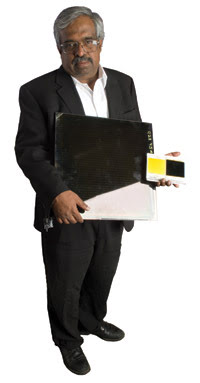An Interview with W.S. Sampath
 Dr. W.S. Sampath, a professor of mechanical engineering at Colorado State University in Fort Collins, has developed a continuous high-throughput automated manufacturing process for solar panels using glass coating with a cadmium telluride (CdTe) thin film. In a technology transfer, the university helped launch a company Sampath co-founded, AVA Solar Inc., also of Fort Collins, where high-efficiency solar modules are produced using the patented manufacturing process. After a few successful rounds of financing, AVA Solar expects to produce 200 MW of photovoltaic modules a year at a cost competitive with electricity in many parts of the world. The first modules are expected to come off the assembly line in a few months.
Dr. W.S. Sampath, a professor of mechanical engineering at Colorado State University in Fort Collins, has developed a continuous high-throughput automated manufacturing process for solar panels using glass coating with a cadmium telluride (CdTe) thin film. In a technology transfer, the university helped launch a company Sampath co-founded, AVA Solar Inc., also of Fort Collins, where high-efficiency solar modules are produced using the patented manufacturing process. After a few successful rounds of financing, AVA Solar expects to produce 200 MW of photovoltaic modules a year at a cost competitive with electricity in many parts of the world. The first modules are expected to come off the assembly line in a few months.
You went through 17 years of research. There must have been some difficult moments for you.
My research started in 1991, and it was motivated by research on aluminum can manufacturing. The idea is that there are tens of processes involved in making a can, but the can still sells for less than a half a cent more than the cost of the material. I thought that if you could make solar cells with this kind of manufacturing efficiency, it could be the answer to our energy needs.
Mass-producing solar cells at a low cost must have had its challenges. Can you describe what some of the obstacles were?
The main challenge was in developing the electrical contacts to cadmium telluride. We showed that, with the optimum amount of copper, we can make stable electrical contact. Using cadmium telluride, the cost of the material was kept low, but we had to determine the right amount of copper for the contacts. The second challenge was to scale the process. Doing it in the lab is one thing, but we didn’t know how it would scale. It turns out that the scalability of our process was very good. We scaled from 3 inches by 3 inches up to 16 inches by 16 inches and now up to 2 feet by 4 feet.
What motivated you to keep going?
We believed that if you can do the manufacturing process like that of aluminum cans we could have an energy solution. It didn’t look that hard compared to what it could accomplish.
You are a scientist first and foremost. What have you learned that you can share with other scientists planning to start a business?
Back in 2006, the president of Colorado State University knew we were doing good research in the lab, and he got the vice president [of the university] involved in a technology transfer. They knew we needed a CEO to run the business. And that was the right thing to do, because I’m not a businessman. When they got the CEO onboard, he attracted the first round of investors, and from there the business has taken off on its own.
AVA Solar’s Web site claims that it will be able to produce solar panels at less than $1 per watt and that 200 MW will power 40,000 US homes. Is that realistic?
Yes, because, like many big companies, AVA Solar is very good at partnering with companies that are developing different parts of the puzzle. They’ve got a glass manufacturer, a laser producer, a vacuum company and others who can deliver parts of this machine. AVA Solar is responsible for integration and the design of process heads, and the process is really fine-tuned. The $1 per watt is very realistic, considering the kind of money AVA has raised and the caliber of people it employs. No one else comes close at this point. There’s no materials shortage when you’re using cadmium telluride thin film. And while other companies will soon try to get in the game, there’s frankly room for many of us.
Will your technology be directed toward individual homes or large-scale projects such as solar “parks”?
Right now there’s no shortage of takers in large utility-scale installations, so that’s where AVA will start.
Some manufacturers are putting solar on unusual structures, such as window shades or objects that look like trees. Do you see your technology being used on anything other than a traditional panel?
Not really, because we’re going for volume in order to make an energy contribution. We’re looking toward gigawatts of manufacturing.
The solar industry is growing rapidly – regionally. What trends do you see as significant?
Most of the salespeople who show up on AVA’s doorstep are from Germany, and initially they may have to sell a lot in Germany. With the new administration in the US, things might be different, and, certainly, California is leading the way. Still the solar industry in Germany is very strong.
You have waited a long time for the solar market to take off. Do you think the time is now, and what impact do you expect from the recent extension of the renewable energy tax credit in the US?
The extension of the tax credit will be a big benefit and should contribute to the overall growth in the market.